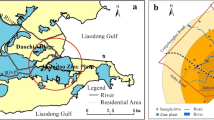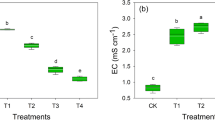Abstract
Incorporation of organic materials into soil improves the soil sorption capacity, while limiting the mobility of metals in soil and their availability to plants. These effects can be taken advantage for remediation of soils polluted with heavy metals. The objective of this study is to assess the remediatory potential of peat applied to soils with concomitant pollution with Cd, Pb, and Zn. Two 1-year experiments were run in microplots in which maize was grown as the test plant. The following treatments were compared on two soils (sandy soil and loess): (1) control, (2) heavy metals (HM), (3) HM + peat in a single dose, and (4) HM + peat in a double dose. Maize was harvested in the maturity stage; the biomass of roots and aerial parts, including grain and cobs, was measured. Besides, concentration of metals in all those plant parts and the net photosynthetic rate and transpiration rate were determined. The approach of using peat in soil remediation led to satisfactory results on sandy soil only. The application of peat to sandy soil caused significant changes in the accumulation of the metals and their translocation from roots to other parts of plants, which resulted in a higher intensity of photosynthesis and an increase in the maize biomass compared to the HM treatment.

Similar content being viewed by others
References
Ahmad MSA, Ashraf M, Tabassama Q, Hussain M, Firdous H (2011) Lead (Pb)-induced regulation of growth, photosynthesis, and mineral nutrition in maize (Zea mays L.) plants at early growth stages. Biol Trace Elem Res 144:1229–1239. doi:10.1007/s12011-011-9099-5
Al Chami Z, Cavoski I, Mondelli D, Miano T (2013) Effect of compost and manure amendments on zinc soil speciation, plant content, and translocation in an artificially contaminated soil. Environ Sci Pollut Res 20(7):4766–4776. doi:10.1007/s11356-012-1439-2
Brawn PA, Gill SA, Allen SJ (2000) Metal removal from wastewater using peat. Wat Res 34(16):3907–3916
Brennan MA, Shelley ML (1999) A model of the uptake, translocation, and accumulation of lead (Pb) by maize for the purpose of phytoextraction. Ecol Eng 12:271–297
Burzynski M, Klobus G (2004) Changes of photosynthetic parameters in cucumber leaves under Cu, Cd, and Pb stress. Photosynthetica 42(4):505–510
Chen X-H, Gosset T, Thevenot DR (1990) Batch copper ion binding and exchange properties of peat. Water Res 24(12):1463–1471
Chugh LK, Sawhney SK (1999) Photosynthetic activities of Pisum sativum seedlings grown in presence of cadmium. Plant Physiol Biochem 37(4):297–303
Ci D, Jiang D, Wollenweber B, Dai T, Jing Q, Cao W (2010) Cadmium stress in wheat seedlings: growth, cadmium accumulation and photosynthesis. Acta Physiol Plant 32:365–373. doi:10.1007/s11738-009-0414-0
Cotter-Howells JD, Caporn S (1996) Remediation of contaminated land by formation of heavy metal phosphates. Appl Geochem 11:335–342
Crist RH, Martin JR, Chonko J, Crist DR (1996) Uptake of metals on peat moss: an ion-exchange process. Environ Sci Technol 30(8):2456–2461. doi:10.1021/es950569d
Fisher K (2002) Removal of heavy metals from soil components and soil by natural chelating agents. Part I: displacement from clay minerals and peat by L-cysteine and L-penicillamine. Water Air Soil Poll 137:267–286
Gardea-Torresday JL, Tang L, Salvador JM (1996) Copper adsorption by esterified and unesterified fractions of Sphagnum peat moss and its different humic substances. J Hasard Mat 48:191–206
Ghaly RA, Pyke JB, Ghaly AE, Ugursal VI (1999) Remediation of diesel-oil-contaminated soil using peat. Energ Source 21(9):785–799. doi:10.1080/00908319950014344
Gondek K (2009) Zinc content in maize (Zea mays L.) and soils fertilized with sewage sludge and sewage sludge mixed with peat. Pol J Environ Stud 18(3):359–368
Gosset T, Trancart J-L, Thevenot DR (1986) Batch metal removal by peat. Kinetics and thermodynamics. Water Res 20(1):21–26
Gupta BS, Curran M, Hasan S, Ghosh TK (2009) Adsorption characteristics of Cu and Ni on Irish peat moss. J Environ Manage 90(2):954–960. doi:10.1016/j.jenvman.2008.02.012
Ho YS, Wase DAJ, Forster CF (1995) Batch nickel removal from aqueous solution by sphagnum moss peat. Water Res 29(5):1327–1332
Horacek J, Soukupova L, Puncochar M, Slezak J, Drahos J, Yoshida K, Tsutsumi A (1994) Purification of waste waters containing low concentrations of heavy metals. J Hasard Mat 37:69–76
Hu L, Diez-Rivas C, Hasan AR, Solo-Gabriele H, Fieber L, Cai Y (2010) Transport and interaction of arsenic, chromium, and copper associated with CCA-treated wood in columns of sand and sand amended with peat. Chemosphere 78(8):989–995. doi:10.1016/j.chemosphere.2009.12.019
Jarausch-Wehrheim B, Mocquot B, Mench M (1999) Absorption and translocation of sludge-borne zinc in field-grown maize (Zea mays L.). Eur J Agron 11:23–33
Kabata-Pendias A, Motowicka-Terelak T, Piotrowska M, Terelak H, Witek T (1993) Assessment of contamination level of soil and plants with heavy metals and sulphur, IUNG Pulawy Publisher, P(53): 1–20 (in Polish)
Kiikkila O, Pennanen T, Perkiomaki J, Derome J, Fritze H (2002) Organic material as a copper immobilising agent: a microcosm study on remediation. Basic Appl Ecol 3:245–253
Korzeniowska J, Stanislawska-Glubiak E, Igras J (2011) Applicability of energy crops for metal phytostabilization of soils moderately contaminated with copper, nickel and zinc. J Food Agric Environ 9(3–4):693–697
Kumpiene J, Lagerkvist A, Maurice C (2007) Stabilization of Pb- and Cu-contaminated soil using coal fly ash and peat. Environ Pollut 145:365–373
Lasat MM, Baker AJ, Kochian L (1996) Physiological characterization of root Zn2+ absorption and translocation to shoots in Zn hyperaccumulator and nonaccumulator species of Thlaspi. Plant Physiol 112(4):1715–1722. doi:10.1104/pp. 112.4.1715
Lee S-J, Lee M-E, Chung JW, Park JH, Huh KY, Jun G-I (2013) Immobilization of lead from Pb-contaminated soil amended with peat moss. J Chem 2013:1–6. doi:10.1155/2013/509520
Lewinska K, Karczewska A (2013) Influence of soil properties and phosphate addition on arsenic uptake from polluted soils by velvetgrass (Holcus lanatus). Intern J Phytorem 15:91–104
Li ZH, Wang HY, Liang WB, Hu YL, Li KL (2002) Effect of the compound pollution of soil Cd, Zn and Pb on celery in red soil. J Central-South For Col 22(1):36–39
Ma QY, Logan TJ, Traina SJ (1995) Lead immobilization from aqueous solutions and contaminated soils using phosphate rock. Environ Sci Technol 29:1118–1126. doi:10.1021/es00004a034
Nwachukwu OI, Pulford ID (2008) Comparative effectiveness of selected adsorbant materials as potential amendments for the remediation of lead-, copper- and zinc-contaminated soil. Soil Use Manag 24:199–207. doi:10.1111/j.1475-2743.2007.00141.x
Plekhanov SE, Chemeris YK (2003) Early toxic effects of zinc, cobalt, and cadmium on photosynthetic activity of the green alga Chlorella pyrenoidosa Chick S-39. Biol Bull 5:610–616, in Russian
Qian J, Shan X, Wang Z, Tu Q (1996) Distribution and plant availability of heavy metals in different particle-size fractions of soil. Sci Total Environ 187:131–141
Qin F, Wen B, Shan X-Q, Xie Y-N, Liu T, Zhang S-Z, Khan SU (2006) Mechanisms of competitive adsorption of Pb, Cu, and Cd on peat. Environ Pollut 144:669–680
Qufei L, Fashui H (2009) Effects of Pb2+ on the structure and function of photosystem II of Spirodela polyrrhiza. Biol. Trace Elem Res 129:251–260. doi:10.1007/s12011-008-8283-8
Sękara A, Poniedzialek M, Ciura J, Jedraszczyk E (2005) Cadmium and lead accumulation and distribution in the organs of nine crops: implications for phytoremediation. Pol J Environ Stud 14(4):509–516
Sharma DC, Forster CF (1993) Removal of hexavalent chromium using sphagnum moss peat. Water Res 27(7):1201–1208
Song F, Guo Y, Liu XY, Zhang YL (1996) Effect of compound pollution of cadmium, zinc and lead on spinach in brawn earth. Agro-Environ Prot 15(1):9–14
Stanislawska-Glubiak E, Korzeniowska J, Kocon A (2012) Effect of the reclamation of heavy metal-contaminated soil on growth of energy willow. Pol J Environ Stud 21:187–192
Waterlot C, Pruvot C, Ciesielski H, Douay F (2011) Effects of a phosphorus amendment and the pH of water used for watering on the mobility and phytoavailability of Cd, Pb and Zn in highly contaminated kitchen garden soils. Ecol Eng 37:1081–1093
Waterlot C, Bidar G, Pelfrene A, Roussel H, Fourrier H, Douay F (2013) Contamination, fractionation and availability of metals in urban soils in the vicinity of former lead and zinc smelters, France. Pedosphere 23(2):143–159
Wrobel S, Nowak-Winiarska K (2011) Interaction of liming and earthworm humus in detoxification of soil contaminated with excess copper. Pol J Environ Stud 20:1611–1616
Yang Y, Nan Z, Zhao Z, Wang S, Wang Z, Wang X (2011) Chemical fractionations and bioavailability of cadmium and zinc to cole (Brassica campestris L.) grown in the multi-metals contaminated oasis soil, northwest of China. J Environ Sci (China) 23(2):275–281
Zhang L, Zhang H, Guo W, Tian Y, Chen Z, Wei X (2012) Photosynthetic responses of energy plant maize under cadmium contamination stress. Adv Mater Res 356–360:283–286. doi:10.4028/www.scientific.net/AMR.356-360.283
Acknowledgments
The work has been prepared as a part of 2.6 Long-term Program (funded by the Polish Ministry of Agriculture and Rural Development) in the Institute of Soil Science and Plant Cultivation—State Research Institute.
Author information
Authors and Affiliations
Corresponding author
Additional information
Responsible editor: Philippe Garrigues
Rights and permissions
About this article
Cite this article
Stanislawska-Glubiak, E., Korzeniowska, J. & Kocon, A. Effect of peat on the accumulation and translocation of heavy metals by maize grown in contaminated soils. Environ Sci Pollut Res 22, 4706–4714 (2015). https://doi.org/10.1007/s11356-014-3706-x
Received:
Accepted:
Published:
Issue Date:
DOI: https://doi.org/10.1007/s11356-014-3706-x




